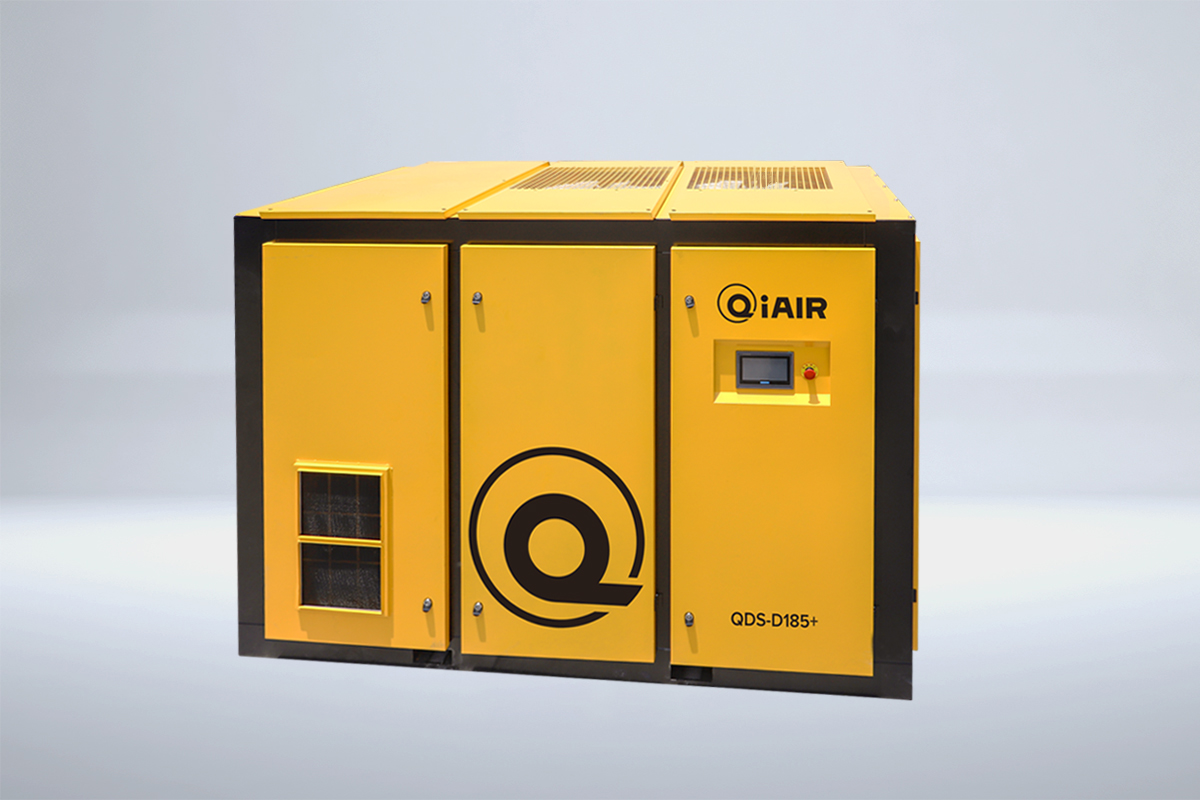In many production systems, the compressor is a very critical link. Today, I will summarize the questions and answers about compressors that you usually encounter, which are full of dry goods.
I. What are the characteristics of centrifugal compressors?
Centrifugal compressor is a kind of turbine compressor. It has the characteristics of large processing gas, small volume, simple structure, stable operation, convenient maintenance, gas pollution, and many driving forms that can be adopted.
II. How does the centrifugal compressor work?
Generally speaking, the main goal of increasing the gas pressure is to increase the number of gas molecules per unit volume, that is, to shorten the distance between gas molecules and molecules. In order to achieve this goal, aerodynamics method is adopted, that is, using mechanical work elements (high-speed rotating impellers) to work on gases, so that The pressure of the gas is increased under the action of the centrifugal formula, and the kinetic energy is greatly increased. Then this part of the kinetic energy in the diffuser channel is converted into static pressure energy, which further increases the gas pressure. This is the working principle of the centrifugal compressor.
III. What are the common prime movers of centrifugal compressors?
Common prime movers of centrifugal compressors are: motors, steam turbines, gas turbines, etc.
IV. What are the auxiliary equipment of centrifugal compressors?
The operation of the centrifugal compressor host is premised on the normal operation of the auxiliary equipment, which includes the following aspects:
(1) Lubricant system.
(2) Cooling system.
(3) Condensed water system.
(4) The electrical instrument system is the control system.
(5) Dry gas sealing system.
V. What are the types of centrifugal compressors according to their structural characteristics?
According to the structural characteristics, centrifugal compressors can be divided into horizontal segmentation, vertical segmentation, isothermal compression, combination and other types.
VI. What parts are the rotor composed of?
The rotor includes the spindle, impeller, shaft sleeve, shaft nut, compartment, balance plate and thrust plate.
VII. Definition of level?
The stage is the basic unit of a centrifugal compressor, which is composed of an impeller and a set of fixed elements that match it.
VIII. Definition of paragraph?
The steps between each inlet and the exhaust port form a section, which consists of one or more levels.
IX. Definition of cylinder?
The cylinder of a centrifugal compressor consists of one or more segments, and a cylinder can accommodate at least one level and a maximum of ten.
X. Definition of columns?
High-pressure centrifugal compressors sometimes need to be composed of two or more cylinders, arranged by one cylinders or several cylinders on an axis to become a column of centrifugal compressors. Different columns have different rotation speeds. The rotation speed of high-voltage columns is higher than that of low-pressure columns. For columns at the same speed (coaxial), the impeller diameter of high-pressure columns is greater than low. Press the column.
11. What is the role of impeller? What are the types of structural characteristics?
The impeller is the only component of the centrifugal compressor to work on the gas medium. Under the centrifugal thrust of a high-speed rotating impeller, the gas medium rotates with the impeller to obtain kinetic energy and partially converted from the diffuser into pressure energy. Under the action of centrifugal force, it is thrown out of the impeller mouth and along the expander, corner, The reflux enters the next impeller and further pressurizes until it is discharged from the outlet of the compressor.
According to the structural characteristics, impellers can be divided into three types: open, semi-open and closed.
12. What is the maximum flow condition of a centrifugal compressor?
When the flow rate reaches the maximum, it is the maximum flow condition, resulting in two possibilities:
First, the airflow at the throat of a runner in the stage reaches a critical state. At this time, the volumetric flow rate of the gas is already the maximum. No matter how low the back pressure of the compressor decreases, the flow rate cannot increase, and this working condition has also become a "blocking" condition.
Second, the runner has not reached a critical state, that is, there is no "blocking" condition, but under a large flow rate, the compressor loses a lot of flow, and the exhaust pressure that can be provided is very small, almost close to zero energy. It can only be used to overcome the resistance in the exhaust pipe to maintain such a large flow rate, which is centrifugal. Maximum flow conditions of the compressor.
13. What is the surge of a centrifugal compressor?
During the production and operation of centrifugal compressors, there are sometimes sudden strong vibrations, and the flow and pressure of the gas medium also pulsates significantly, accompanied by periodic dull "call" sound, and the strong noise caused by airflow fluctuations in the pipe network. This phenomenon is called centrifugal compression. The surge conditions of the machine.
The compressor cannot run for a long time under the respirating condition. Once the compressor enters the respir working condition, the operator shall immediately take adjustment measures to reduce the export pressure, or increase the import or export flow, so that the compressor can quickly get out of the respillation area and realize the stable operation of the compressor.
14. What are the characteristics of the surge phenomenon?
Once the operation of the centrifugal compressor occurs, the operation of the unit and the pipe network has the following characteristics:
(1) The outlet pressure and inlet flow rate of the gas medium vary greatly, and sometimes the gas backflow may also occur. The gas medium is discharged from the compressor to the inlet, which is a dangerous condition.
(2) The pipe network has periodic vibration, large amplitude, low frequency, and periodic roar.
(3) The compressor body vibrates strongly, the housing and bearings have strong vibration, and makes a strong periodic airflow sound. Due to the strong vibration, the bearing lubrication conditions will be damaged, the shaft tile will burn out, and even the shaft will be torn off, the rotor and the stator will cause friction, collision, and the sealing element will be seriously damaged.
15. How to adjust anti-asthma vibration?
The harm of surge is great, but so far it cannot be eliminated in design. We can only try to avoid the operation of the unit from entering the respirating condition during operation. The principle of anti-asthma is to immediately try to increase the flow rate of the compressor when the surge is about to occur, so that the operation of the unit can be separated from the surge area. There are three specific ways to prevent asthma:
(1) Partial gas air defense method.
(2) Partial gas reflux method.
(3) Change the speed method of the compressor.
16. Why is the operation of the compressor below the limit of surge?
(1) The back pressure of the outlet is too high.
(2) The inlet pipeline valve is throttled.
(3) The outlet pipeline valve is throttled.
(4) The anti-asthma valve is defective or the adjustment is incorrect.
17. What are the working conditions adjustment methods of centrifugal compressors?
Because the process parameters in production inevitably change, it is often necessary to manually or automatically adjust the compressor so that the compressor can adapt to the production requirements and operate under variable conditions to maintain the stability of the production system.
There are generally two kinds of adjustment of centrifugal compressors: one is isovoltage adjustment, that is, adjusting the flow rate under the premise that the back pressure remains unchanged; the other is, equal flow adjustment, that is, adjusting the exhaust pressure of the compressor while ensuring that the flow rate remains unchanged. Specifically, there are the following five adjustment methods:
(1) Export flow regulation.
(2) Import flow regulation.
(3) Change the speed adjustment.
(4) Rotating the inlet guide blade adjustment.
(5) Partial emptying or reflux adjustment.
18. What is the impact of rotational speed on the performance of the compressor?
The speed of the compressor has the function of changing the performance curve of the compressor, but the efficiency remains unchanged, so it is the best form of the compressor adjustment method.
19. What is the meaning of isosuring adjustment, isot flow adjustment and proportional adjustment?
(1) Equal pressure adjustment means keeping the exhaust pressure of the compressor unchanged and only changing the adjustment of gas flow.
(2) Equal flow adjustment refers to keeping the flow rate of the conveying gas medium of the compressor unchanged, but only changing the adjustment of the discharge pressure.
(3) Proportional adjustment refers to the adjustment that keeps the pressure ratio unchanged (such as anti-asthma adjustment) or the percentage of volumetric flow of the two gas media unchanged.
20. What is a pipe network? What are its components?
Pipeline network is a pipeline system for a centrifugal compressor to realize the task of gas media transmission. It is called the inhalation pipe before the entrance of the compressor, and the pipe after the exit of the compressor is called the discharge pipe. The sum of the inhalation and discharge pipe is usually called the pipe network.
The pipe network is generally composed of four elements: pipeline, pipe fittings, valves and equipment.



